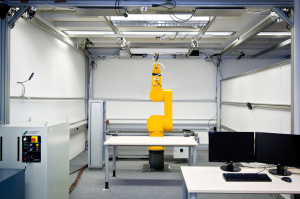 In a human-robot cooperation (right figure), the integrity of human collaborators in the robot cell is critical due to the robot’s speed and weight. The integrity can only be ensured if the precise location of the human collaborator is known. However, the vision within the scene is partly obscured by static and dynamic obstacles (racks, tables, robot). In order to locate the collaborator, multiple cameras need to be installed and a 3D background subtraction method as well as plausibility tests need to be applied. Each distinct camera adds a different perspective of the scene and each additional perspective refines the global understanding of the scene. However, repositioning a camera means varying its perspective and thereby modifying the scene understanding. So, the quality of this artificial vision system depends on the parameters of the sensors. Moreover, modifying one of the parameters has an influence on the safety of the human collaborator.
In a human-robot cooperation (right figure), the integrity of human collaborators in the robot cell is critical due to the robot’s speed and weight. The integrity can only be ensured if the precise location of the human collaborator is known. However, the vision within the scene is partly obscured by static and dynamic obstacles (racks, tables, robot). In order to locate the collaborator, multiple cameras need to be installed and a 3D background subtraction method as well as plausibility tests need to be applied. Each distinct camera adds a different perspective of the scene and each additional perspective refines the global understanding of the scene. However, repositioning a camera means varying its perspective and thereby modifying the scene understanding. So, the quality of this artificial vision system depends on the parameters of the sensors. Moreover, modifying one of the parameters has an influence on the safety of the human collaborator.
Generally, an artificial vision system with multiple cameras is used to observe an environment ![]() and the observability
and the observability ![]() of the system is measured by the number of observed items or paths, the area of the observed boundary, the observed volume of the environment, or by the error of reconstruction or tracking algorithms. The dependence of the vision system on the choice of camera parameters
of the system is measured by the number of observed items or paths, the area of the observed boundary, the observed volume of the environment, or by the error of reconstruction or tracking algorithms. The dependence of the vision system on the choice of camera parameters ![]() suggests that a set of optimal parameters exists that optimizes the observability.
suggests that a set of optimal parameters exists that optimizes the observability.
In literature, two general optimal camera placement problems are discussed. The Art Gallery Problem usually comes down to minimizing the number of cameras in predefined mounting spots ![]() with respect to completely observing the objects or boundary of the given 2D environment. More generally, the costs
with respect to completely observing the objects or boundary of the given 2D environment. More generally, the costs ![]() of the vision system are minimized while the observability
of the vision system are minimized while the observability ![]() is bounded in the constraints.
is bounded in the constraints.
![]()
The reverse problem is derived from the Maximal Set Covering Location Problem and determines the optimal placement of a given number of cameras. The observability is maximized or minimized while the camera parameters are constrained. Here, ![]() includes a predefined mounting area, constraints on the orientation of the cameras and other conditions on
includes a predefined mounting area, constraints on the orientation of the cameras and other conditions on ![]() depending on the environment or the signal strength.
depending on the environment or the signal strength.
![]()
In order to solve each problem type automatically, the observability of multiple cameras needs to be adequately analyzed to provide an analytic formula of the function of ![]() or simulated computationally.
or simulated computationally.